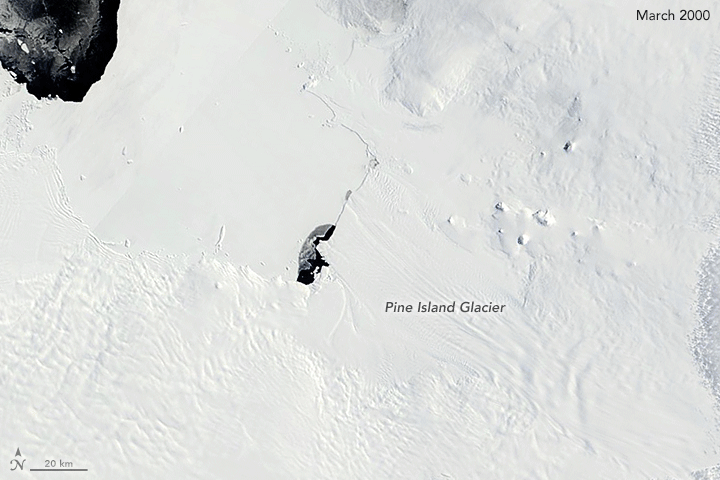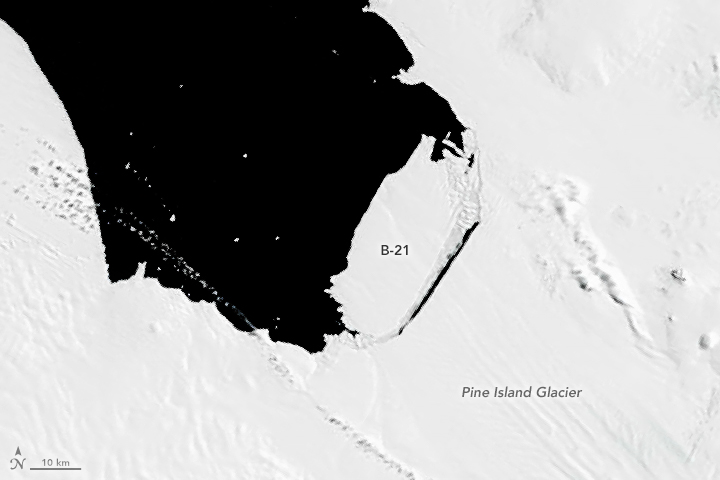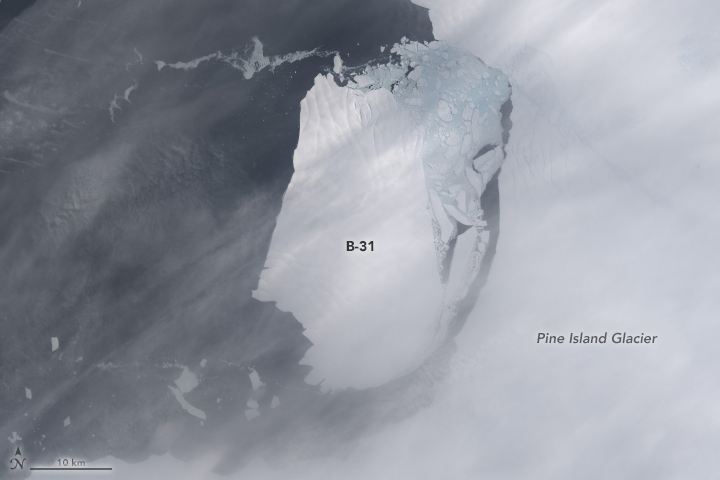

April 9, 2019

NASA Earth Observatory animation by Lauren Dauphin, using MODIS data from NASA EOSDIS/LANCE and GIBS/Worldview.
Most people will never see Pine Island Glacier in person. Located near the base of the Antarctic Peninsula—the “thumb” of the continent—the glacier lies more than 2,600 kilometers (1,600 miles) from the tip of South America. That’s shorter than a cross-country flight from New York to Los Angeles, but there are no runways on the glacier and no infrastructure. Only a handful of scientists have ever set foot on its ice.
While this outlet glacier is just one of many around the perimeter of Antarctica, data collected from the ground, air, and space confirm that Pine Island is worth extra attention. It is, along with neighboring Thwaites Glacier, one of the main pathways for ice entering the Amundsen Sea from the West Antarctic Ice Sheet and one the fastest-retreating glaciers in Antarctica. Collectively, the region contains enough vulnerable ice to raise global sea level by 1.2 meters (4 feet).

NASA Earth Observatory map by Lauren Dauphin, using Reference Elevation Model of Antarctica (REMA) data from the Polar Geospatial Center at the University of Minnesota.
The animation at the top of this page shows a wide view of Pine Island Glacier (PIG) and the long-term retreat of its ice front. Images were acquired by the Moderate Resolution Imaging Spectroradiometer (MODIS) on NASA’s Terra satellite from 2000 to 2019. Notice that there are times when the front appears to stay in the same place or even advance, though the overall trend is toward retreat.
“The process of how a large outlet glacier like Pine Island ‘shrinks’ has some interesting twists,” said Bob Bindschadler, an emeritus NASA glaciologist who landed on Pine Island Glacier’s ice shelf in 2008.
Decades of investigations have given scientists a better idea of the quirks of PIG’s behavior. For example, data collected during science flights in 2009 led researchers to discover a deep-water channel (map below) that could funnel warm water to the glacier’s underbelly and melt it from below.

NASA Earth Observatory map by Jesse Allen, based on a model by Michael Studinger of NASA IceBridge and gravity data from Columbia University.
Bindschadler explained that a shrinking outlet glacier is usually doing three things: thinning (mostly at the seaward edge), retreating, and accelerating. The acceleration stretches the glacier, causing the thinning and likely making the ice more prone to crevassing (cracking) “upstream.”
Fractures near the seaward edge cause the ice to calve off as icebergs, a normal part of life for glaciers that extend over water. If icebergs calve off at a rate that matches the glacier’s acceleration, the ice front stays in the same place.
But over the long term at Pine Island, you can see that the ice front has retreated inland, which means the calving rate has increased more than the glacier has accelerated. “This underlies our concern that retreating outlet glaciers can ‘shrink’ rapidly,” Bindschadler said.

This photo, shot by NASA science writer Kate Ramsayer during a research flight on November 7, 2018, shows sea ice between Pine Island Glacier and the newly calved Iceberg B-46.
Large calving events used to take place at Pine Island Glacier every four to six years. More recently, calving has occurred on a near-annual basis and the bergs tend to break up more easily into smaller pieces.
Large cracks are forming farther upstream from the ice front than ever before—even in the middle of the ice shelf, where scientists had never previously seen them grow. “This is indicative of a progressive collapse of the ice shelf,” said Eric Rignot, a glaciologist at NASA’s Jet Propulsion Laboratory.
The following images, acquired with Terra MODIS and the Operational Land Imager (OLI) on Landsat 8, show Pine Island Glacier’s most notable calving events over the past two decades.

NASA Earth Observatory image by Lauren Dauphin, using MODIS data from NASA EOSDIS/LANCE and GIBS/Worldview.
A rift in the glacier first became visible on September 10, 2000, in images from NASA’s new Terra satellite, but the cracking probably started in the darkness of austral winter. The rift continued to spread across the glacier until it finally calved on November 9, 2001. (It is possible that the calving occurred one day prior, but clouds prevented a clear look.) The behemoth measured 42 kilometers long and 17 kilometers wide, an area of 714 square kilometers. The image above shows the iceberg on November 11, 2001.
Pinpointing the exact birthdate of icebergs using natural color images can be a challenge. Darkness engulfs the poles during winter, and in months when there is ample sunlight, clouds can obscure the view. Scientists often use radar and thermal imagery to get a better look under these less-optimal conditions.

NASA Earth Observatory image by Lauren Dauphin, using MODIS data from NASA EOSDIS/LANCE and GIBS/Worldview.
An image from MODIS on the Aqua satellite first showed Iceberg B-27 on September 28, 2007. But once again, the calving might have happened some days before under cloud cover. The image above shows a clear view from October 15, 2007.
You have probably noticed that each iceberg has the letter “B,” in its name. The U.S. National Ice Center assigns names to sizeable icebergs depending on the quadrant of Antarctica in which the berg was first sighted. In the case of bergs from Pine Island Glacier and others that start in the Amundsen and Eastern Ross seas, the names begin with “B”.

NASA Earth Observatory image by Holli Riebeek, using Landsat data from the U.S. Geological Survey.
Sometime between November 9 and November 11, 2013, a large iceberg separated from the front of Pine Island Glacier. Landsat 8 captured this view on November 13, 2013. The berg, named B-31, measured 700 square kilometers.
Until this point, large icebergs were calving from Pine Island Glacier every four to six years. That was about to change.

NASA Earth Observatory image by Lauren Dauphin, using Landsat data from the U.S. Geological Survey.
Researchers reported anomalous rifts forming between 2013 and 2015 on Pine Island Glacier. Unlike previous cracks, these originated from the center of the glacier and propagated outward toward the margins. The pattern indicated stresses at the center of the ice shelf. The cracks, like the one visible in this image from March 8, 2015, were a precursor to further retreat of the ice front.

NASA Earth Observatory image by Lauren Dauphin, using Landsat data from the U.S. Geological Survey.
In August 2015, the U.S. National Ice Center reported that a calving event had occurred in the darkness of winter, likely in late July. The event produced a number of sizeable icebergs including B-41, which was still close to the shelf when this image was acquired on November 26, 2015. B-35 had drifted farther from the ice front.
The calving of icebergs during the austral winter is not surprising. While there tends to be more sea ice at this time of year, it is no match for the huge stresses within the massive ice shelf.

NASA Earth Observatory image by Joshua Stevens, using Landsat data from the U.S. Geological Survey.
On September 28, 2017, the OLI on Landsat 8 acquired this image of the recently calved Iceberg B-44. The berg had an area of 185 square kilometers. By October 15, fragments had already fallen below 70 square kilometers (20 square nautical miles)—the minimum size required for tracking by the U.S. National Ice Center.
Around this time, Pine Island Glacier started to shed smaller icebergs more frequently. Scientists think the change in calving frequency is likely related to the thinning of the ice shelf. Thinning can destabilize the shelf because the ice loses contact with points on the ocean floor that strongly influence its grounding or stability.

NASA Earth Observatory image by Lauren Dauphin, using Landsat data from the U.S. Geological Survey.
At the end of October 2018, the European Space Agency’s Sentinel-1 satellite observed the glacier letting go of a huge chunk of ice. The largest piece, named Iceberg B-46, spanned 226 square kilometers. It is visible here on November 7, 2018, as observed by Landsat 8. NASA’s Operation IceBridge flew over the berg that same day. Check out some photographs from that flight here.
New rifts were already visible in satellite images on November 2018. It is possible that these fractures could spawn a new iceberg in 2019.
Editor’s Note: Earth Observatory would like to thank the following scientists for help with image interpretation: Eric Rignot/JPL, Robert Bindschadler/NASA GSFC (emeritus), Christopher Shuman, UMBC/NASA GSFC, and Chris Readinger/U.S. National/Naval Ice Center.